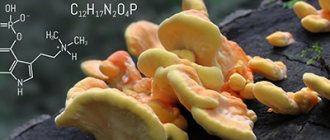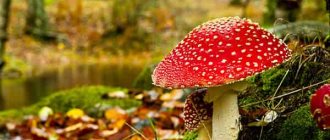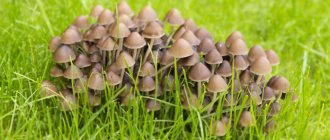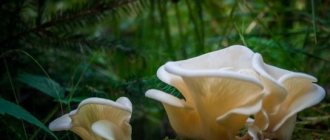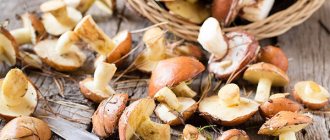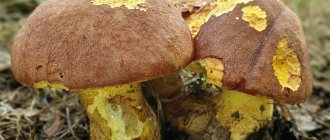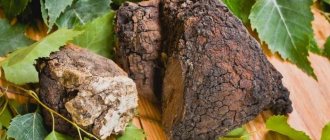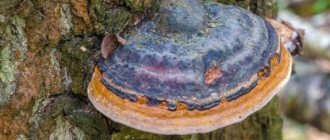Content
- 1 General
- 2 Konocibe
- 3 Copelandia
- 4 Galerina
- 5 Gymnopilus
- 6 Inotsibe
- 7 Panelol
- 8 Foliotina
- 9 Plutai
- 10 Psilocybe 10.1 A
- 10.2 billion
- 10.3 C
- 10.4 D
- 10.5E
- 10.6F
- 10.7 g
- 10.8 hours
- 10.9 i
- 10.10 K
- 10.11 l
- 10.12M
- 10.13 north latitude
- 10.14 O
- 10.15P
- 10.16Q
- 10.17 R
- 10.18 S
- 10.19 t
- 10.20 U
- 10.21 V
- 10.22 W
- 10.23 X
- 10.24Y
- 10.25 Z
Psilocybin mushrooms of the world, Part 2.
psychoactive
Hello my dear friend!
We continue our excursion into the world of hallucinogenic mushrooms, namely psilocybin mushrooms. We have already partially become acquainted with the genus Cubensis, with its strain subspecies (of which, by the way, there are many more). But we’re not going to stop there. The thing is that the world of psilocybin mushrooms is wide (__mother joke__) and multifaceted; The genus Psilocybe are cosmopolitans that can be found almost anywhere in the world (especially in growers' apartments).
Let's start the review with the most popular varieties in Russia, continuing to the more exotic (spoiler - and cool (spoiler in the spoiler - not always ( Neo, wake up !!!))).
Semilanceata
Here they are, healthy ones!
Also called “veselushka”, “prushka”, “liberty cap”, these are the most common mushrooms in Russia and the CIS.
Almost always, when someone you know says, “Lyonka got drunk on mushrooms, lol)),” it’s about semilanceates.
Dosage:
0.6 g for a 1st level trip 1.7 g for a 3rd level trip 3.6 g for a 5th level trip
“Veselushki” are a rather strong species in terms of alkaloid content - up to 1.4% in total (most of them are psilocybin and beocystin, a little psilocin).
Growing:
Requiring acidic soil and being a symbiote with the grass Soddy pike, it is difficult to grow semi-lanceolate brothers (or sisters? hmm..). There are several grow reports on the Internet, but it seems that no one has yet succeeded in creating a reproducible technology.
Slozhno
Speaking of ease of growing... On to the next contestant!
Cubensis
A cube's a cube's a cube ('sa cube...)
Yes, that's them. The most popular species in the world. Most likely, in the raised bookmark with mushroom seals - these are exactly them, in one of the many variations.
There is an interesting myth associated with Cubes about the strong differences between strains. According to reviews, some subtypes give stronger visuals, others give a pleasant body high, and others more often cause synesthesia.
In reality, the differences in the nature of the trip and potency have more to do with the substrate/growing conditions (more nutrients, especially those involved in the biosynthesis of psilocybin and psilocin (spoiler - most often the limiting factor is a lack of phosphorus ) - a “stronger” result. The only “subtype” of cubes that really differs significantly in strength (almost everyone confirms that 1.5-2.5 less mushrooms by weight are required for a trip) is Penis Envy and its “brothers” - PE6, APE (Albino).
Do you want to talk about this?.. Sit down...
Dosage:
The usual dosage for the effects to be noticeable is 0.75-1 grams. (for microdosing - lower, 0.2-0.5 grams; however, this is a topic for a separate article). The standard dosage is considered to be 1/8 ounce, in the West it is called an eighth.
Anything above 5 grams of dried mushrooms can be considered a strong dosage. Terrence McKenna, perhaps the most famous evangelist of the use of psilocybin mushrooms and mycologist (psilocybist? psilocybinist? Is an evangelist psilocybist?), advised to eat exactly 5 grams, in silence and darkness, to obtain a “transcendental experience” and a strong transformation of consciousness.
Hello darkness my old friend I've come to talk with you again Because those visuals slowly-yy creepin' And here's my own self, oh God, depletin' And the words...stop making any sense Is this the end?... Or just a new beginning?
Growing: Perhaps it is thanks to the ease of growing that Cuba has become so popular. After the work of creating the growing technology of the McKenna brothers, as well as Psilocybe Fanaticus with its PF-Tek, mushrooms came to every home (well, almost). Tolerance to temperature and carbon dioxide content, resistance to infections, willingness to “eat” any substrate with an appetite - all this makes Cubensis almost ideal for home cultivation.
Sometimes cubes grow even where it was not expected:
How do you like this, Elon Musk?!
Sclera-forming species (tampanensis, mexicana, atlantis, gallindoi)
Truffles NNADA?
The only mushrooms allowed in the Netherlands. Although, what kind of mushrooms are these... Sclerotium is something like eggs (no, not steel ones) that some types of mushrooms “lay”/form under unfavorable conditions in order to wait out the “storm” (at least someone listened to Ed Stark and prepared for winter!) .
Many note a consistency similar to nuts, a pleasant taste (surprise - with nutty notes), as well as less nausea compared to Cubes, despite the larger required dosages.
By the way, sclerovids can be collected as usual - they are universal fighters
Dosage:
Due to the fact that truffles contain only 74-75% water, and not 90-94%, as in ordinary fruiting bodies, an interesting phenomenon is observed - if you compare fresh cubes and truffles, the latter have a higher alkaloid content by weight. However, after drying, we will find that for a good trip, not 35, but 3 grams of mushrooms are required, however, as with truffles, the situation will be completely different.
In general, for standard fresh truffles (let’s not take into account the differences in types for now), the recommended dosage is 7-10 grams for a weak trip, about 15 for medium strength, 20+ for a strong, complete immersion.
Now about the types of truffle carriers - they differ in strength, that’s a fact. If you bought magic nuts (no, this is a very strange association, we’re actually talking about mushrooms here!) in a smart shop somewhere in Amsterdam, there will be instructions on the box with the dosage of a specific type. If you decide to grow it yourself, there is a lot of information on the Internet + you’d better know what you’re growing
Growing:
Remember when we said that Cubensis is the easiest species to grow? Eh, forget it.
Growing in one step - that's our way!
Truffles grow directly in a jar of colonized substrate; the only drawback is that it takes a little longer to heal - 3-4 months (however, the longer you keep the jar, the stronger the result will be). Those. This is ordinary growing, only without the fruiting stage.
Panaeolus cyanescens/tropicalis/cambodginiensis
We decided to combine these three species for a simple reason - they are approximately equal in strength, growing conditions and appearance. About the latter - according to the author, these are one of the most beautiful hallucinogenic mushrooms:
SEXEH
A distinctive feature of these species is the presence of very decent amounts of serotonin and 5-HTP in the fruiting bodies, which affects the nature of the trip - it is called much more visual, with virtually no stress on the body and nausea (even in those predisposed to it).
Dosage:
These are one of the most powerful types of mushrooms - translating the name of the first, we get Psilocybe Blue. The characteristic reaction of turning blue is a sign, according to experts, of oxidation of active substances (minor, however - after a couple of minutes in the air, you shouldn’t feel sad about blue fruits and season your pizza with psilocybes instead of champignons, unless, of course, you accidentally want to enlighten all the guests.
Blue, like the children of the sky!
Also a distinctive feature is the start of the action - with the Pans it is faster, 15-25 minutes. As one grower from the Shroomery website wrote, “Having eaten a gram (and I have more than 80 trips with cubes under my belt), after 20 minutes I could no longer figure out how to remove the headphones, because... I didn’t understand what this thing was in principle. The effect was an order of magnitude stronger than the Cubensis; do not underestimate the Paneolus.”
In general - 0.3-0.5 g for a weak trip on the verge of perception, 1-1.5 g for a trip of medium strength, and 2-3+ for the beaten ones, oh, that is, for experienced psychonauts!
Growing:
Being a little more (but not too) whimsical species than Cubensis, the main changes for growing these species are:
- Manure is desirable. Or at least hay with compost. This is really important, the grain will have a tiny harvest with weak griboules.
- We need more fresh air - many people install air pumps with humidifiers. A can or monotube most likely won’t be very suitable (although if you do some farming...).
- Be careful with mixing and tearing the colonized substrate. Although the gentlemen capture goodies at cosmic speed, the mycelium is not rhizomorphic and not strong - it is much easier to damage it and introduce infection.
- Do not be confused by the appearance and smell - the first is often similar to the “tricha” of a well-known rival of the mycelium in any substrate, and the second is, let’s say, specific, not as “mushroomy” as that of the Cubes.
However, you shouldn’t be afraid, and after a couple of cycles of growing Cubes, perhaps everyone can grow a crop of Panov
Sandoz Domesticate (stabilized strain, for growing) and Subphauri Goliath (large, fast, strong) are considered the “strongest” and most adaptable - they are the easiest to grow. On a note
Panaeolus bisporus
This name is not without reason - the main difference from the previous brethren from O̶t̶ts̶a̶, ̶ ̶С̶ы̶н̶а̶ ̶и̶ ̶С̶в̶я̶т̶а̶г̶о̶ ̶Д̶у̶х̶а̶, ̶ ̶А̶м̶и̶н̶ь̶ of the three Pans - double disputes (bisporus - " double-spoiled"):
My humps, my humps my humps Some lovely sporal lumps
Main habitat: North Africa (have you ever wondered where the shamans come from?), Spain, Switzerland, Hawaii (along with Thailand and South America - the “forge of talent” for hallucinogens. Sometimes after reading the descriptions of the species, it seems that in the Amazon jungle you can stumble over vine and accidentally trip)
When you walk through the jungle...
An even less popular species than the trinity of Panov, therefore no less interesting - both in the type of spores and in appearance (however, not much - the main difference is in color):
Dosage:
Some note potency equal to the rest of the Pans, others report a little more - it’s impossible to say for sure.
What can be said for sure - tread carefully, careless dosing in the style of “ahh lol, yes, I didn’t take that out, it’s crap))” can send you into an eternal trip in the style of Mol from the movie Inception under Bohemian Rhapsody, which continues even after the trip itself - the strongest HPPD with derealization:
Is this the real life Is this just fantasy? Ate a bit too much (muuush) Will I ever live normally?
Growing:
It cannot be said that the science of growing Bisporus is in any way different from Panaeolus - manure, air, a little love (without this ingredient nothing will work) and a lot of practice with sterility - and you're done!
Psilocybe azurescens/cyanescens
Let's fly now!
Let's move on to the bosses of the level - lovers of sugars and lignin, blue "flying saucers".
According to the results of numerous studies of alkaloid content, these species are consistently in the top. Again we turn to the translator from Latin - “heavenly” and “blue”. I think everything is clear with their color when damaged
They grow in cold places in Europe and the USA, in forests, on the noses of druids... However, what am I talking about.
A distinctive feature of the Azurs, in addition to simply wild potency (up to 2% alkaloids by weight!), is the content of a non-toxic paralytic agent, which (coincidence?) forces the tripper to lie down during the journey. Not a bad defense against psychosis with running friends in the style of “Ahhhh, where is my axe, there are dragons everywhere?!?!??!”, isn’t it?
Dosage:
We take an average dose of psilocybin of 15 mg, take the average alkaloid content of 1.5%, perform magic with numbers, we get 1 gram... For a mind-blowing trip, 2-2.5 grams will be enough, no more + for the most experienced.
Growing:
Everything is more complicated here. Let's start with the fact that these are the so-called woodlovers - they feed mainly on wood, sawdust, and also love cold (when I say “cold”, I mean the fruit compartment in the refrigerator - +4-+10).
The standard method (growing at home is very hemorrhoidal, we prefer to trust the specialists from Western forums) is to start with jars/bags with a nutrient substrate, easier - grain (you can do sawdust/hay right away); the next step, which can be skipped if there is an abundance of substrate from the “first step,” is colonizing bags with sawdust in order to multiply the volume of colonized substrate and the mass of mycelium. Then a woodbed is prepared for the mycelium, which will delight you for many years
My very, very, very dear little forest, the most tender, the dearest
